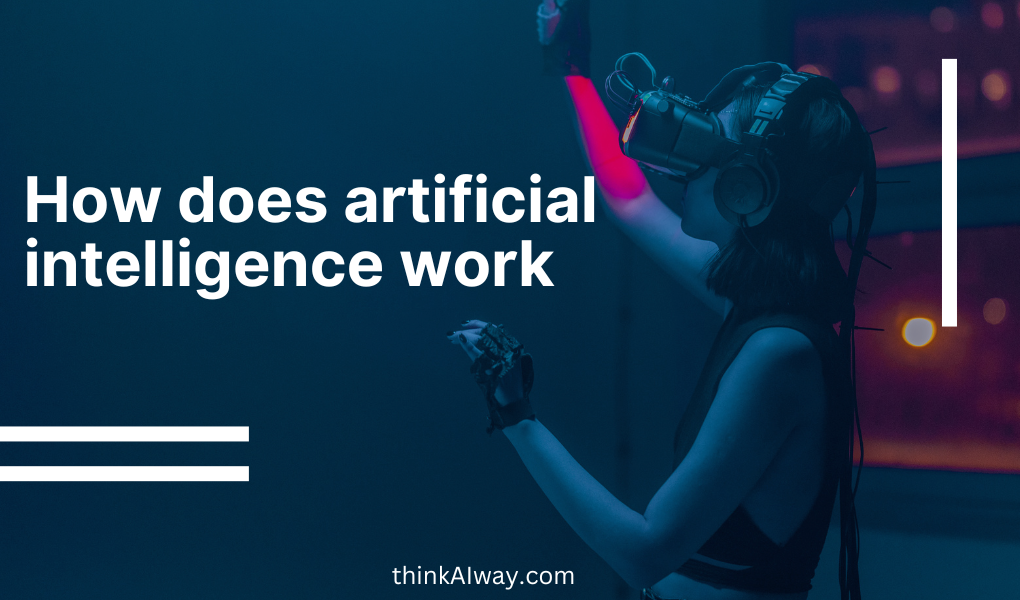Artificial Intelligence (AI) refers to the development of computer systems and software that can perform tasks that typically require human intelligence. These tasks include learning, reasoning, problem-solving, understanding natural language, speech recognition, and visual perception. Artificial Intelligence systems are designed to mimic certain aspects of human intelligence and can be classified into two broad categories:

- Narrow or Weak Artificial Intelligence: This type of Artificial intelligence is designed to perform a specific task or a narrow range of tasks. Examples include voice assistants like Siri and Alexa, image recognition software, and recommendation algorithms.
- General or Strong Artificial Intelligence: This is a more advanced form of AI that possesses the ability to understand, learn, and apply knowledge across a wide range of tasks—similar to human intelligence. General AI is still largely theoretical and does not currently exist in practice.
Artificial Intelligence systems utilize various techniques, including machine learning, natural language processing, computer vision, and robotics. Machine learning, a subset of AI, involves training algorithms on large datasets to enable the system to learn patterns and make predictions or decisions without explicit programming. it is very useful for people in many ways.
Key components of Artificial intelligence include:
- Machine Learning (ML): Algorithms that enable systems to learn and improve from experience without being explicitly programmed.
- Natural Language Processing (NLP): AI’s ability to understand, interpret, and generate human language.
- Computer Vision: AI’s ability to interpret and make decisions based on visual data, such as images or videos.
- Robotics: The integration of AI into physical machines to perform tasks in the physical world.
Artificial Intelligence is applied across various industries and domains, including healthcare, finance, education, manufacturing, and more. Its applications range from automation and optimization of processes to creating intelligent systems capable of complex decision-making. While AI has made significant advancements, challenges remain, including ethical considerations, bias in algorithms, and ensuring transparency and accountability in AI systems.
history of ARtificial INtelligence
The term “artificial intelligence” was coined at the Dartmouth Conference in 1956, where John McCarthy, Marvin Minsky, Nathaniel Rochester, and Claude Shannon gathered to discuss the possibility of creating machines that could simulate human intelligence. but AI has become more popular nowadays. I have explained the history of Artificial intelligence in table below years wise and revolution-wise.
| 1950-1960 | 1970-1980 | 1980-1990 | 2000-2010 | 2010- Presents |
| Early AI programs | AI Winter | Expert systems & Neural network | Machine Learning & Big data | Deep Learning & AI |
Early AI Programs (1950s – 1960s):
- Logic Theorist (1956): Allen Newell and Herbert A. Simon developed the Logic Theorist, the first AI program, which could prove mathematical theorems.
- General Problem Solver (GPS, 1957): Newell, Simon, and J.C. Shaw created GPS, an AI program capable of solving a wide range of problems.
AI Winter (1970s – 1980s):
- Despite initial optimism, progress in AI faced challenges, leading to a period known as the “AI Winter.” Funding and interest in AI research decreased due to unmet expectations and technical limitations.
Expert Systems and Neural Networks (1980s – 1990s):
- Expert Systems: The 1980s saw the development of expert systems, rule-based programs designed to emulate human expertise in specific domains.
- Connectionism and Neural Networks: Interest in neural networks was revived, exploring models inspired by the structure and function of the human brain.
Rise of Machine Learning and Big Data (2000s – 2010s):
- Machine Learning: Advances in machine learning algorithms, particularly in areas like natural language processing and computer vision, led to breakthroughs in AI applications.
- Big Data: The availability of vast amounts of data and increased computing power facilitated the training of more sophisticated machine learning models.
Deep Learning Revolution (2010s – Present):
- Deep Learning: Deep neural networks, especially deep learning models like convolutional neural networks (CNNs) and recurrent neural networks (RNNs), achieved remarkable success in tasks such as image recognition and natural language processing.
- AI Applications: AI applications have become widespread in various industries, including healthcare, finance, transportation, and entertainment.
Ongoing Developments:
- Ethical Considerations: Growing awareness of ethical considerations, transparency, and responsible AI development.
- AI in Robotics: Integration of AI in robotics, autonomous vehicles, and other physical systems.
- AI in Healthcare: Advancements in AI-driven diagnostics, drug discovery, and personalized medicine.
How does artificial intelligence work
Artificial Intelligence (AI) works through the use of algorithms and computational models that enable machines to perform tasks that traditionally require human intelligence. The process involves several key components and techniques. Here’s a simplified explanation of how artificial intelligence works:

- Data Collection:
- AI systems often require large amounts of data to learn and make predictions. This data may include text, images, videos, or other types of information relevant to the task the AI is designed to perform.
- Data Preprocessing:
- Raw data needs to be processed and cleaned to remove noise, errors, or irrelevant information. This step ensures that the data is suitable for training and analysis.
- Feature Extraction:
- Relevant features or characteristics are identified within the data. For example, in image recognition, features might include edges, shapes, or textures.
- Algorithm Selection:
- Depending on the task, a specific algorithm or a combination of algorithms is chosen. Machine learning algorithms, such as decision trees, support vector machines, or neural networks, are commonly used.
- Training the Model:
- During the training phase, the AI model is fed with labeled data (input with corresponding desired output). The algorithm learns to recognize patterns and relationships within the data.
- Adjusting Parameters:
- The algorithm adjusts its internal parameters based on feedback received during training. This process is iterative and continues until the model achieves satisfactory performance.
- Model Evaluation:
- The trained model is tested on new, unseen data to evaluate its performance. This step helps ensure that the model can generalize well to different examples beyond the training set.
- Inference or Prediction:
- Once trained, the AI model can make predictions or decisions when presented with new, unseen data. For example, a trained image recognition model can identify objects in new images.
- Feedback Loop (Iterative Process):
- AI systems often operate in an iterative process. Feedback from real-world performance is used to continuously improve the model. This may involve retraining the model with updated data or adjusting its parameters.
- Deployment:
- Once a model is trained and validated, it can be deployed for use in various applications, automating tasks or assisting humans in decision-making.
It’s important to note that there are different types of AI, including rule-based systems, machine learning, and deep learning. Deep learning, a subset of machine learning, involves neural networks with many layers (deep neural networks) and has been particularly successful in tasks such as image and speech recognition.
The effectiveness of an AI system depends on the quality and quantity of the data it is trained on, the appropriateness of the chosen algorithms, and the iterative refinement
Why ARTIFICIAL INtelligence is important
Artificial Intelligence (AI) is important for several reasons, and its significance spans various industries and aspects of our daily lives. Here are some key reasons why AI is considered important:
- Automation and Efficiency:
- AI enables the automation of repetitive and mundane tasks, allowing machines to handle routine activities more efficiently. This automation leads to increased productivity and allows humans to focus on more complex and creative aspects of their work.
- Data Analysis and Pattern Recognition:
- AI systems can analyze large volumes of data at incredible speeds, identifying patterns and trends that may not be apparent to humans. This capability is particularly valuable for decision-making, forecasting, and strategic planning in various fields.
- Personalization and User Experience:
- AI powers recommendation systems and personalization features in products and services. This improves user experience by delivering tailored content, recommendations, and services based on individual preferences and behavior.
- Innovation and Research:
- AI plays a crucial role in scientific research and innovation by helping researchers process and analyze vast amounts of data. It accelerates the discovery of new patterns, insights, and solutions in fields such as healthcare, biology, and materials science.
- Problem Solving and Decision Support:
- AI systems excel at problem-solving and decision-making in complex scenarios. They can process information, assess various factors, and recommend optimal solutions, supporting human decision-makers across industries.
- Enhanced Customer Service:
- AI-powered chatbots and virtual assistants provide immediate and personalized customer support. These systems can handle inquiries, resolve issues, and guide users through processes, enhancing overall customer service experiences.
- Medical Applications:
- In healthcare, AI is used for diagnostic purposes, drug discovery, and personalized medicine. AI algorithms can analyze medical images, predict disease outcomes, and assist healthcare professionals in making more informed decisions.
- Financial Analysis and Trading:
- AI is extensively used in the financial industry for tasks such as algorithmic trading, risk management, fraud detection, and credit scoring. It helps financial institutions make data-driven decisions and manage risks effectively.
- Accessibility and Inclusion:
- AI technologies contribute to creating more inclusive environments by providing accessibility features for people with disabilities. Voice recognition, text-to-speech, and image recognition technologies, for example, make technology more accessible to a broader range of users.
- Societal Impact:
- AI has the potential to address some of society’s most pressing challenges, including climate change, poverty, and public health. It can contribute to innovative solutions and aid in the development of technologies that benefit communities globally.
While AI brings numerous benefits, it’s important to consider ethical considerations, transparency, and responsible use to ensure that AI technologies are deployed in a manner that aligns with societal values and norms. Balancing innovation with ethical considerations is crucial for harnessing the full potential of artificial intelligence.
